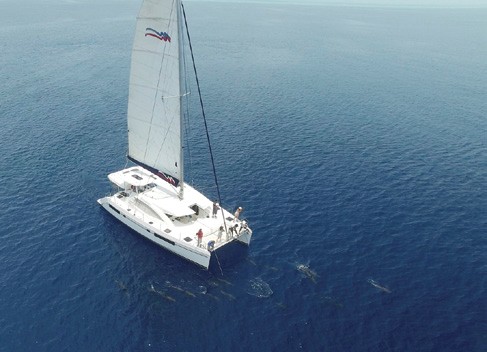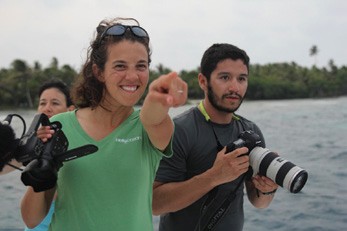By Ben Carey
 Sailing is a fantastic way to explore the world. I’ve heard many people say the sailing lifestyle is “living the dream.” But for my wife Teresa and I, sailing with a purpose felt more dreamy. We needed a way to give back, which is why we started Hello Ocean, an organization that expands ocean conservation and research through citizen science and educational media.
Sailing is a fantastic way to explore the world. I’ve heard many people say the sailing lifestyle is “living the dream.” But for my wife Teresa and I, sailing with a purpose felt more dreamy. We needed a way to give back, which is why we started Hello Ocean, an organization that expands ocean conservation and research through citizen science and educational media.
This Leopard catamaran, generously loaned by The Moorings, was an ideal platform for Hello Ocean’s Expedition Underway. © helloocean.org
Expedition Underway, our first research-under-sail expedition, conducted in partnership with The Moorings, headed to Belize for some pioneering marine mammal research. Surprisingly, there is very little known about the dolphin populations in the coastal waters of Belize in the western Caribbean. The Mesoamerican Reef, the world’s second largest barrier reef, provides nearly 700 miles of protected sailing and hundreds of islands. Most of them are empty and small, devoid of restaurants, mega yachts and supplies. Once you leave the mainland, you are “out there.”
The Moorings was thrilled to help support this groundbreaking research, and provided a 48-foot Leopard catamaran that served as our research platform. It was comfortable and spacious enough for our crew of eight to live aboard, conduct meetings, and set up a mini genetics and audio lab. Better still, the dolphins loved to “bow ride” the waves created by the twin hulls. Bow riding is similar to body surfing, and dolphins do it for the same reason humans do – because it’s fun!
If you ask a scientist how many and what kind of dolphins live in Belizean waters, the answer would be, “We don’t know.” It is hard to believe, but up until our survey there had been no systematic study on population data of cetaceans in the offshore waters of Belize. For seven days the team, including scientists Eric Ramos and Dr. Nataly Castelblanco, conducted the first systematic survey on cetaceans in Belize. In other words, we counted whales and dolphins to see how many there are living in that region. We also collected data in support of 5Gyres’ efforts to combat the high levels of marine debris in the world’s oceans.
How did we do it? We sailed along transecting lines and logged cetacean sightings, collected tissue samples, recorded audio samples, and took aerial and surface photos to identify the animals and observe behaviors. Interestingly, the dorsal fin of each dolphin has markings on it – notches, scratches or nicks – that create unique patterns, much like a fingerprint. The photos are then cataloged so that by identifying individual dolphins, scientists can begin to determine the population size and study their range and behavior.
Regulations don’t allow bareboat charters outside the barrier reef, but with local skipper Jeremy aboard, we were able to run transects between three offshore atolls; Glovers, Lighthouse and Turneffe. “This is the strangest charter I have ever done,” Jeremy said, referring to our daily morning meetings, our dinner conversations of scientific jargon, and rigorous hours spent staring at the horizon looking for dolphins and floating trash. We didn’t stop for lunch, to explore the amazing islands of Belize, or snorkel the best reefs. We were on a mission.
Each day began around 0700 with breakfast and a morning meeting to ensure a cohesive and focused effort. We decided to take two-hour shifts, with someone always positioned at each of the four corners. Watching the horizon for hours is harder than it sounds. Systematically sweeping back and forth trying not to miss a piece of trash or a ripple in the water that could turn into a surfacing dolphin is tiring!
By noon the first day we had already logged 49 pieces of trash floating in the water – plastic bags, bottles, wrappers, buckets, cups and plenty of unidentifiable pieces less than an inch long. Plastic degrades every time it’s recycled, producing a “new” material of lesser quality. As a result, eventually, all plastic becomes trash. According to a study by 5Gyres, we recover only about five percent of the plastic we produce; while half goes into landfills, the remainder is “unaccounted for.” Worse still, plastic leaches toxins continuously and sea creatures often mistake it for food. When they eat it, it could harm or kill them, or contaminate our own food supply.
“Dolphins at three o’clock!” came the shout from the starboard bow. In an outbreak of excitement, everyone grabbed their equipment and ran forward. Research assistants Benito Hernandez and Alton Jeffords positioned themselves on each bow with a biopsy tip fixed to the end of a 15-foot pole. The biopsy tip is a hollow cylinder with a tiny blade designed to scratch the skin of the dolphin, and collect a small skin and tissue sample. Meanwhile Nataly, Eric and assistant Kristi Collum began snapping pictures while my Hello Ocean co-founder Teresa Carey and I were rolling video. Jeremy kept us with the dolphins as long as possible.
 The excitement was high as the pod closed in on us, leaping and playing in the bow wave, diving under the boat, swimming away and then coming back. “Ten o’clock, surfacing,” Eric shouted, and we all ran over to the port side, snapping pictures as fast as we could.
The excitement was high as the pod closed in on us, leaping and playing in the bow wave, diving under the boat, swimming away and then coming back. “Ten o’clock, surfacing,” Eric shouted, and we all ran over to the port side, snapping pictures as fast as we could.
“Dolphins at three o’clock!” Teresa Carey spots a pod while Eric Ramos readies the camera. ©helloocean.org
When a dolphin was within inches of the surface, Benito thrust the pole downward in an attempt to tap its back. He’s a pro, collecting a good sample without even causing them to flinch.
“The skin and tissue samples are used to gather baseline genetic information as well as measure toxin levels,” explained Nataly. “Because dolphins are top predators in the food chain, they accumulate a lot of toxins and contaminants. Measuring the concentration of these contaminants is a good indication of the status of the ecosystem in general.”
“It will help us determine if these individuals here in Belize are at more risk than other populations and be able to advocate for their protection in an area that doesn’t have it yet,” added Eric.
To get a better look at dolphin behaviors, we used a drone equipped with an HD camera for aerial surveys. “It gives us two things. First, we can better determine how many animals we are seeing,” Eric explained. “Second, we can observe their behavior. We know very little about the behaviors of the animals that live in deep waters. For instance how they organize themselves, or what kind of social interactions they engage in.”
One day, after a pod of dolphins had played with us for several hours, Eric and Kristi pulled out the hydrophone (underwater microphone), and Jeremy shut down the engines, creating a surreal moment as we sat quietly on the aft deck in the glassy calm. The dolphins were tired and swimming lazily alongside. Kristi dipped the hydrophone in the water.
Dolphins make sounds for communication and echolocation, a method for locating objects by producing a short blast of sound, similar in function to the depth sounder of a boat. Dolphins do this to gather a wide variety of information about their environment. Underwater we heard a cacophony of clicks and whistles. Long siren sounds, rapid machine-gun clicking, and slow popcorn pops.
We surveyed 267 nautical miles, tirelessly observed for 31 hours, documented encounters with nearly 150 marine mammals using seven aerial drone surveys, 1,200 photos and four hydrophone deployments. To effectively manage and protect cetacean populations, we need to know things like animal abundance, their range and how these phenomenon change over time. To do that, it starts as all scientific inquiry does, one piece of data at a time.
Watch the expedition video:
To find out how you can join future expeditions, visit helloocean.org and sign up for the email list. Hello Ocean’s conservation and research projects are made possible through public support.
Hello Ocean co-founders Ben & Teresa Carey are award-winning sailors and filmmakers who also operate an expedition-style sailing school called Morse Alpha. Visit morsealpha.com to learn more, and check Teresa’s excellent blog, Sailing Simplicity & The Pursuit of Happiness, at sailingsimplicity.com.



